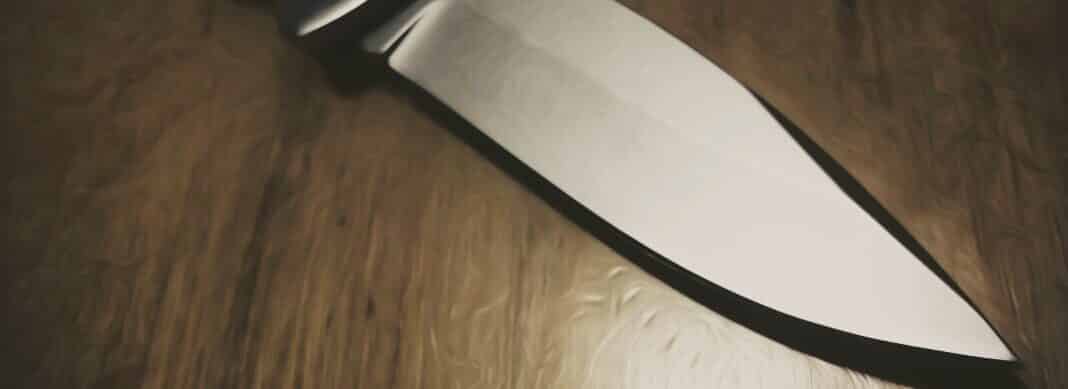To most people, a knife is made up of 2 parts: a handle and a blade. Most people view a knife in this simplistic way, but to know your knife even better, you need to understand how each part of your knife determines how it’s used.
The grind is one of the most forgotten characteristics of a knife. It’s referring to how the blade’s thinned to show the cutting edge or the shape of the blade’s cross-section. Believe you me, the kind of grind your knife has changes the entire behaviour of the blade.
As such, it’s important to know the various edges on knives to better understand how to look after your knife and how to get the most out of it.
While the most common kinds of knife grinds include flat, hollow, convex, double-devel, chisel, and Scandi grind. The main focus of this post is the Scandi grind.

So… What’s a Scandi Grind?
The Scandi grind is also called the Scandinavian or Sabre grind and refers to a form of flat grind. It’s also sometimes known as a V-grind.
As the V-grind name implies the Scandi grind is V-shaped, but the angle doesn’t fully go up to the spine. There’s a bevel partway all the way down the blade instead. So, a good chunk of the blade has a similar thickness to the spine.
As the name suggests, the Scandi grind originated from Scandinavia. It’s commonly seen in hunting knives, bushcraft knives, and outdoor knives. In fact, the Scandi grind is one huge secondary edge, minus any extra frills like curves or scallops seen in other knives.
The Scandi grind is practical in that you can sharpen it with ease and it’s easy to produce. Moreover, it’s perfect for woodworking. As the blade is quite thick, it’s unbelievably strong and can certainly handle a fair bit of cutting.
In addition, due to the huge, wide edge, you’ll be able to see everything you’re doing while using it.
If you’ve made a mistake, you’ll immediately be able to tell if you look at the wide edge. If you’ve chipped the edge, you’ll need to get rid of plenty of material to sort out the mistake.
How a knifemaker creates a scandi grind in a new blade
Sharpening the Scandi grind
Work the edge until you feel a small burr while you run your fingertip off the cutting edge on the opposite side. You want a burr along the entire edge. Once you’ve created a burr along the whole length of the cutting edge, turn your knife over and start the same process on the other side.
Once you’re able to feel the burr along the entire length of the first side, you’ve created the edge. Now you need to get rid of the burr. Lightly stroke the blade over the sharpening stone as though you’re removing slices from the surface.
At this juncture, you should move in a single direction only, beginning with the edge, as though you’re cutting the stone. Make sure the bevel stays flat. Switch between sides, moving the burr backward and forward, until it’s properly honed. Finish up on a strop.
Is your blade badly nicked or very dull? If so, you may want to begin with a medium to coarse stone to get rid of the nicks. Then go for the fine stone. Based on your use, it might be wise to repeat the process with diamond plates or finer stone grades.
How to sharpen the belly
After a few minutes, sharpening the flat blade area will begin to feel familiar. After that, you need to sharpen the curved edge area—the belly. Many people dread this task. After all, it’ll be a bit more difficult to maintain the correct angle.
But it’s totally not impossible. Many people make the mistake of turning the knife over to a 45-degree angle against the stone to address that curved area. That’s usually not the simplest method. We suggest you just lift the handle.
Once you do that and maintain the stone’s surface level, you’ll roll towards the belly by yourself. Repeat the process and occasionally ensure you’re sharpening along the whole cutting edge. This insight sometimes surprises even those who’ve been sharpening a long time and never knew this trick.

Summary what is the scandi grind most useful for?
We’ll always need knives as long as we live. Whether it’s kitchen knives, camping knives, hunting knives, military knives, machetes, or axes, we’ll always have things to cut. We cut food, cut boxes and ropes, chisel stone and wood, and clear bushes that have overgrown on our yards.
The type of grind and task at hand will determine the right blade for your job. Consider two things—the purpose of your knife along with the level of maintenance you want to give it. When you’ve figured that out, you can then choose the right grind for the job at hand.
For basic tasks or use in places where they might take a lot of abuse and need to be field sharpened a scandi grind is a great option.
This style of knife was the first I tackled when I started making knives in my home forge. Mostly because they are robust and the bevel is not a complex shape to create and simple to sharpen on a stone